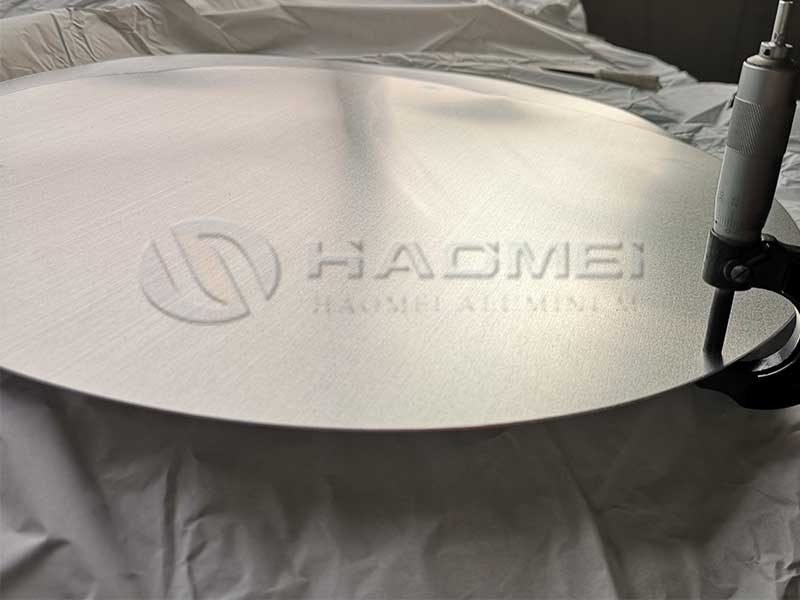Aluminum Circle For Kitchenware Cook Pan
Aluminum Circle For Kitchenware Cook Pan
Explore the significance of aluminum circles in the manufacturing of kitchenware cookware, focusing on their unique properties, technical facets, and diverse applications that enhance culinary experiences.
From a production standpoint, the aluminum circle's gauge (thickness) is critical for cookware. Thinner circles offer lighter pans, appealing to consumers, but require more precise forming to avoid warping or buckling during the pressing and spinning processes. Thicker circles provide superior heat distribution and durability, reducing the likelihood of hot spots and extending the pan's lifespan, but increase material costs. We often see a trade-off between these factors, with manufacturers choosing a "sweet spot" gauge that balances cost with performance expectations. Furthermore, the alloy composition directly affects the circle's workability during fabrication and the final pan's performance. Higher-strength alloys are harder to form but result in stronger, more resistant cookware, while softer alloys are easier to process but may be more prone to denting or scratching.
Our quality control focuses heavily on surface finish. Even minor imperfections on the aluminum circle, like scratches or pitting, can translate into defects in the finished pan, impacting its aesthetic appeal and potentially causing weaknesses. We regularly analyze the surface quality of incoming aluminum circles using specialized inspection equipment to catch these issues early. The specific finishing treatment applied to the circle (e.g., anodizing, coating) is also crucial. It influences both the pan's appearance and its non-stick properties, its resistance to corrosion and wear, and its overall longevity. Choosing the right combination of alloy, gauge, and surface finish for a specific kitchenware application requires
Introduction
When you find yourself standing in front of a savory dish that you've just thoughtfully prepared, it’s easy to misjudge the compact yet robust factor behind it: the cooking pan that heated it. Aluminum circles play a crucial, albeit understated, role in the world of kitchenware cookware. Famed for their adaptability, lightweight nature, and excellent thermal conductivity, aluminum circles have become foundational materials in contemporary culinary equipment, particularly cook pans.
The Allure of Aluminum: Benefits and Features
Aluminum serves as a lightweight alternative compared to its metallic counterparts without compromising structural integrity. One of the outstanding features is its composition, primarily composed of aluminum alloy 1050, 1060, or 1100, famous for their malleability and weldability.
- Lightweight and Portable: Often weighing significantly less than traditional steel, these aluminum circles lend themselves well to user-friendly kitchenware which is especially preferable to everyday cooks or those maneuvering large pots and pans.
- Thermal Conductivity: Perhaps one of the most compelling assets of aluminum is its exceptional thermal properties. Aluminum circles maintain uniform temperatures and distribute heat quickly, resulting in consistent cooking performances. This means brilliantly seared steaks and delectably caramelized vegetables without breaking a sweat.
- Food Safety and Resistance: With a natural oxide layer protecting it from immediate tarnishing, aluminum is a safe alternative for high-temperature cooking environments. It's also a reactive material, meaning additional coatings like anodizing can enhance its resistance to rust and corrosive elements.
Processing of Aluminum Circles in Cookware Manufacturing
Forming aluminum only requires three compelling steps: shaping, machining, and finishing. The processing measures taken heavily dictate both the performance and longevity of the cookware. Heavy-duty sheets are carefully stamped into preform aluminum circles through mechanical presses.
- Shaping - Under functional processes, these significant cutoff weights are carried through tonnage and precision presses, preparing blanks that epicureans approve.
- Machining - Pattern-cutting and adding hangs enhance usability. Cookware manufacturers precisely machine the edges to ensure there’s no sharpness, promoting safety alongside utility.
- Finishing - Once still displays a raw, hefty quality, post-processing makes the surfaces suitable for enthusiast-recommended nonstick coatings, enhancing durability and ease of cleaning.
Diverse Applications of Aluminum Circles in Cookware
Aluminum circles can be found at various levels in the culinary market, supported generically by professional cooks and everyday home kitchens. Breakdown applications of aluminum circles aid in enriching:
- Frying Pans: Considering efficiency and size, fry pans made from aluminum circles excel in disburdening heat uniformly.
- Woks: The assessed wall structure reinforces the classic design's authenticity while encouraging rounded and easy stir-frying of items like vegetables or rice.
- Grill Pans: Aluminum reacts splendidly to direct heat, crafting those perfect grill marks to food from imbibed channels and minimizing uniform adherence.
- Saucepans: Ensuring boiling speeds, the circular shapes retain consistent heat outputs distributing liquids warmly and routinely, avoiding leftover cold batches in any variety of sauces.
https://www.al-alloy.com/a/aluminum-circle-for-kitchenware-cook-pan.html


